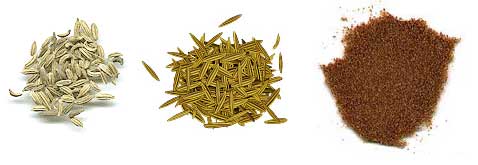 Subscribe to my feed for ingredients
Subscribe to my feed for ingredients  Add to My Yahoo
Add to My Yahoo 
© Copyright 1995-2023, Clay Irving <clay@panix.com>, Manhattan Beach, CA USA
 Subscribe to my feed for ingredients
Subscribe to my feed for ingredients  Add to My Yahoo
Add to My Yahoo
Cumin Characteristics
Pronounced: KUH-mihn; KYOO-mihn; KOO-mihn
Cumin, also known as jeera/zeera or comino, is the second most popular spice in the world (black pepper is number one). The cumin plant is a small annual plant in the parsley family. It has a slender branched stem. The leaves are long and narrow like fennel, but much smaller. The plant produces small white or rose-colored flowers. The flowers produce the fruit of the plant which we call cumin seeds. The seeds are lightly roasted to develop the aroma of cumin. Commercially, cumin is available in whole seeds, or more commonly ground.
Cumin's aromatic, nutty-flavored seeds come in three colors: amber (the most widely available), white and black (both found in Asian markets). White cumin seed is interchangeable with amber, but the black seed has a more complex, peppery flavor. Cumin is one of the main ingredients in curry powders, and the combination of cumin and coriander leaves gives a characteristic smell to much Indian food. Cumin is used extensively in Indian cuisine. Cumin is essential for the preparation of Northern Indian tandoori dishes. Cumin is also a key ingredient in garam masala, a spice mixture used throughout South Asia.
Ground cumin should be stored in a cool, dark place for no more than 6 months. Whole cumin seeds will retain the flavor longer.
Varieties

|